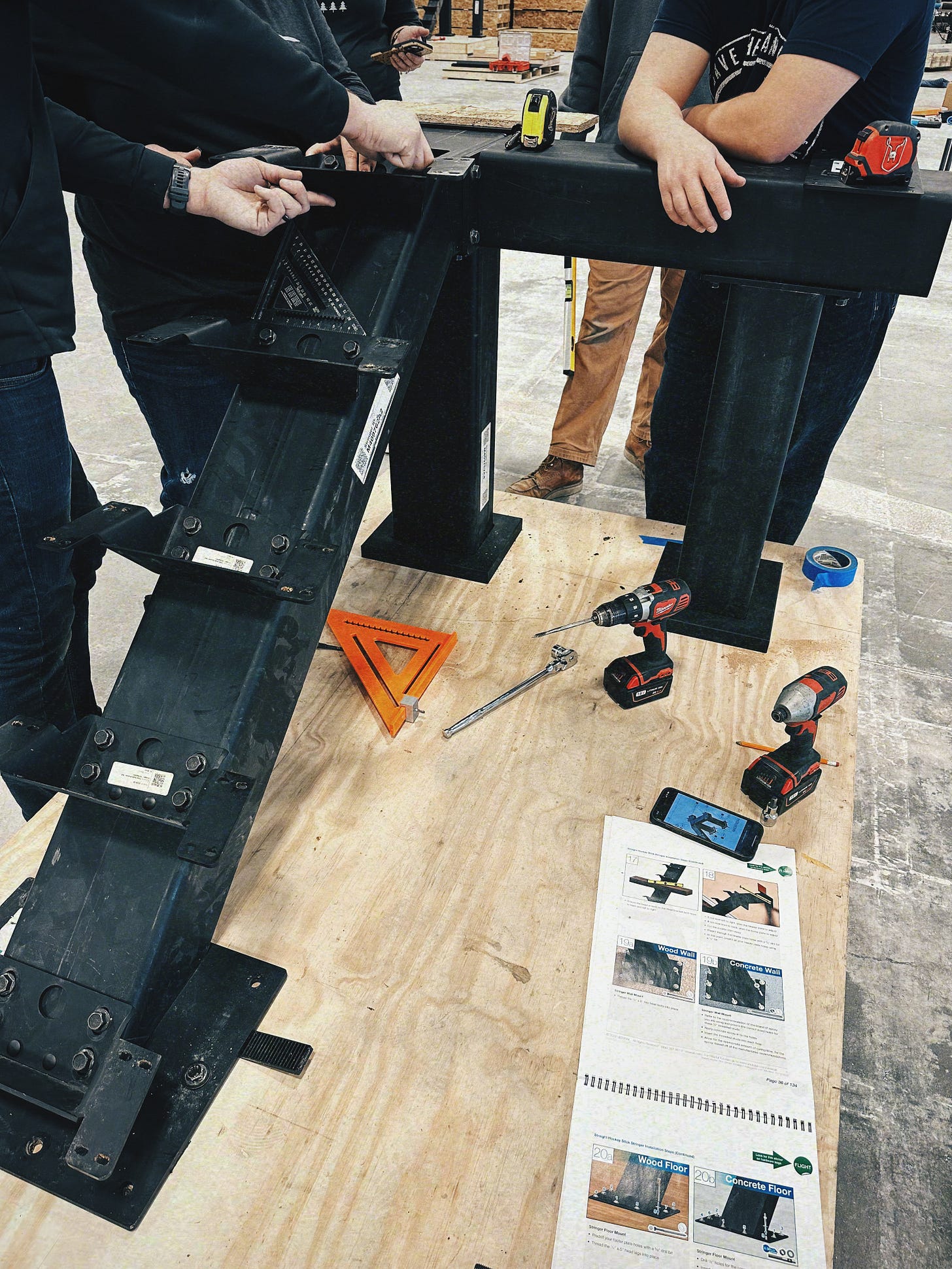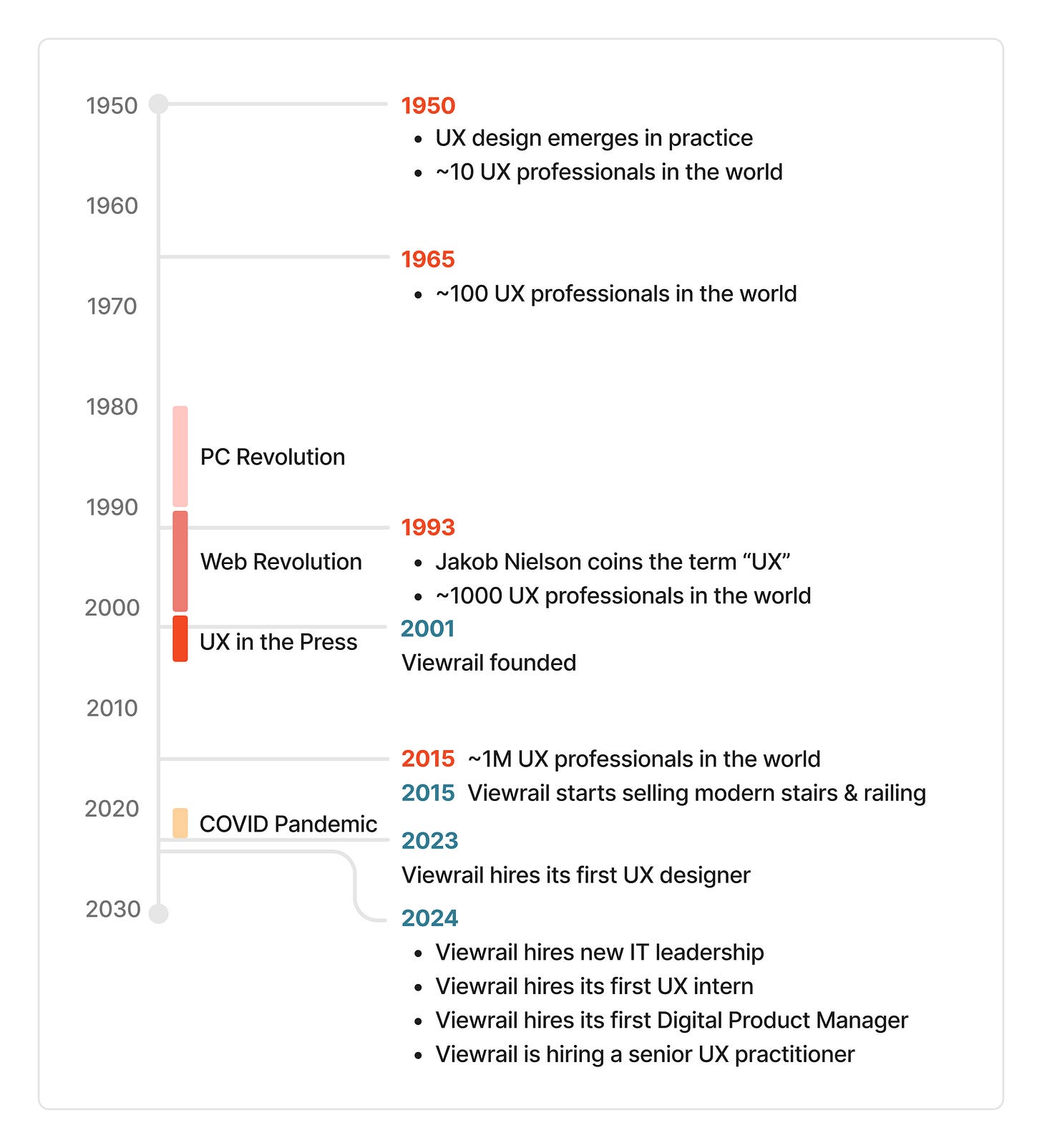The Relative Newness of UX Design, UX Maturity, & History of Viewrail
Work Biweekly Recap | 07.10.24
Stairs & Railing for the People is a work journal from my perspective as an early-career user experience (UX) designer supporting in-house software MVPs at a direct-to-consumer stairs and railing manufacturer in northern Indiana. If you have thoughts, questions, or feedback about things I explore here, I’d love to hear from you.

When I started working at Viewrail as our first UX designer almost a year and a half ago, I knew I had my work cut out for me. I imagine that is generally true for anyone who is the first in a new discipline at a company, but it seemed especially true for me at my level of experience, the kind of company I joined, our place on a map, and the relative newness of UX design.
Most of what I’m curious about in my role is at the intersection of these four factors, and lately I’ve been thinking about the last one: the relative newness of UX design. It emerged as recently as the 1950s in practice, and the 1990s in name, with the growing demand for software usability.1 Given its somewhat recent emergence, the maturity of UX design operations at any organization is measurable, and varies widely, depending on a number of factors according to The Six Stages of UX Maturity by Nielsen Norman Group.
“UX maturity measures an organization’s desire and ability to successfully deliver user-centered design. It encompasses the quality and consistency of research and design processes, resources, tools, and operations, as well as the organization’s propensity to support and strengthen UX now and in the future, through its leadership, workforce, and culture.”
So, what does it look like for us at Viewrail, a direct-to-consumer manufacturing company with a local hiring tendency in a small Midwest city, to mature our in-house UX design operations? I’ve been seeking answers to this question since I started my role, and now we’re at a pivotal moment for UX design at Viewrail.
We recently hired a Digital Product Manager, a role that guides a more holistic vision for digital products. Having filled this position means, potentially, less feature and request-based UX work and more impactful, vision-driven UX work. We are also hiring a senior UX practitioner. This role would increase UX work capacity and, ideally, bring discipline development and design operations leadership experience to the IT team.
This past sprint, I put together a rough timeline of key events in the history of UX design, Viewrail, and UX design at Viewrail:
Links
A 100-Year View of User Experience, Jakob Nielson, Nielson Norman Group
In 1993 Don Norman coined the term “user experience” for his group at Apple Computer…But the field is older than the term…It’s hard to draw the line between traditional human factors and what we might call ‘user-experience’, aimed at human-centered design of interactive systems…
There are a few reasons why UX grew extra fast [from 1983 to ~2015]:
The PC web revolution of the 1990s and 2000s put extra pressure on the computer industry to improve the usability of its products…
The web revolution of the 1990s and 2000s put further pressure on companies to improve the quality of their interaction design…
The great press coverage of usability made UX the “hot new thing” (although it was already 50 years old by 2000, so not really that new).
The 6 Levels of UX Maturity, Kara Pernice, Sarah Gibbons, Kate Moran, and Kathryn Whitenton, Nielson Norman Group
When it comes to UX maturity, no team is an island. A single team or division within a company cannot reach the highest maturity levels, integrated and user-driven stages, while other teams lag behind. It is the consistency among teams which enables these highest maturity levels. Good information, tools, and other resources shared across teams and groups increase UX maturity. Also, UX-focused leadership and knowledge sharing must happen at the organization-wide level, not just within teams. Thus, true UX maturity should be evaluated for an entire organization rather than for a single team.
History of Viewrail, Viewrail Stories on YouTube
Our story is a lot like our community story because on this one hand, we’ve got this Amish community that is very centered on one another and very focused on, on being self-sufficient. And the other side of our community, we have Notre Dame and their [Turbomachinery Laboratory]. So, they’re studying hypersonic transport, and they’re finding ways that literally–we can move something around the world in a matter of minutes, not hours. And so we fuse these two, horse and buggy and hypersonic transport, together and that is the culture, and that is the situation in which Viewrail was born.
We started out just manufacturing things that were just copies of other people’s stuff. Maybe some traditional, timeless designs that aren’t copyrighted, aren’t patented. They’ve just been around for a long time. But then, the breakthrough comes through when we say, “You know what? We’re going to solve big business problems–big market problems that those in the construction industry have.” And it’s, “How do we get this elegant look but make it in a way that is…sustainable materials, make it in a way that’s installer friendly, and really compress the timeline?” And also, like, take what would take four to five trades and bring it into one company, under one set of control. That’s been the beauty of Viewrail.
A 100-Year View of User Experience, Jakob Nielson, Nielson Norman Group






I liked the blending of histories of the UX design and the company. Captures the ongoing evolution of both, and points to the exciting growth of both.